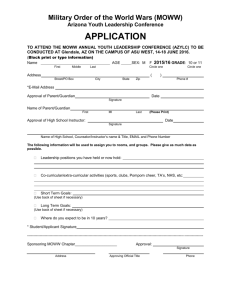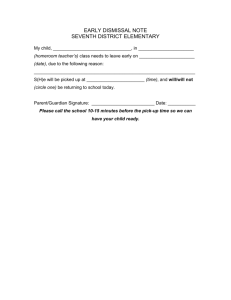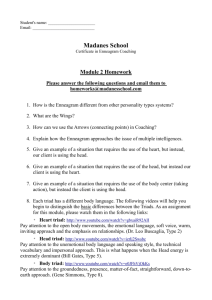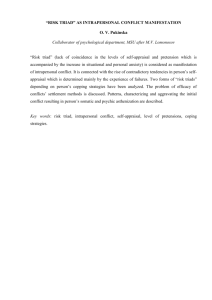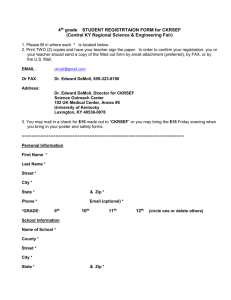File - Emily Robinson
advertisement
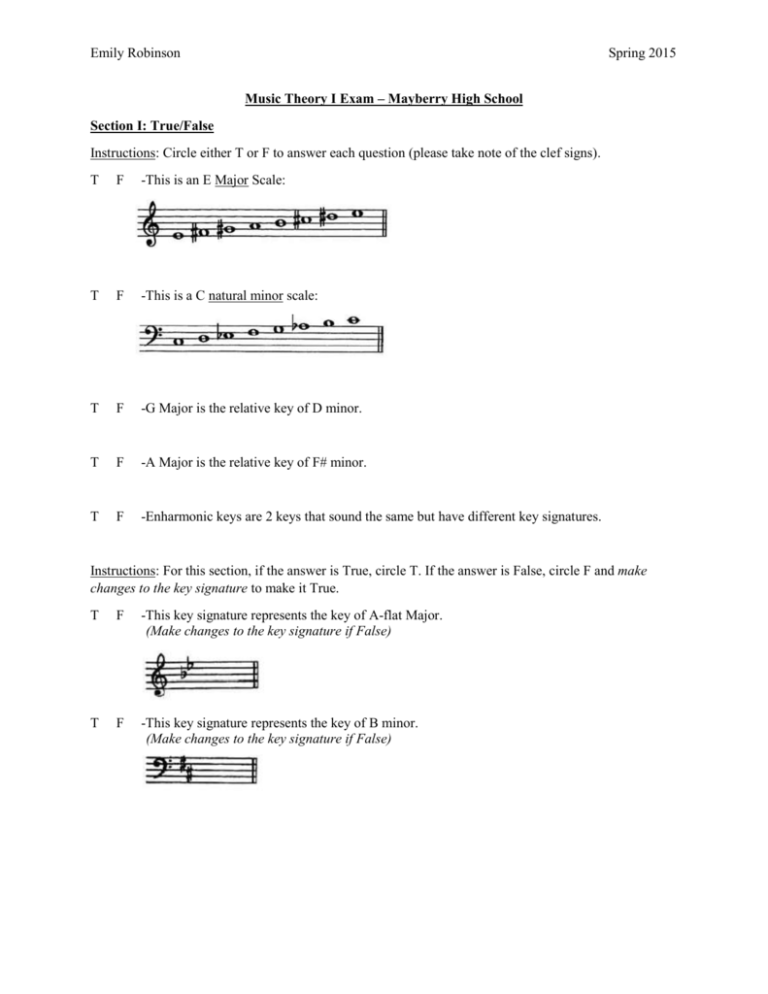
Emily Robinson Spring 2015 Music Theory I Exam – Mayberry High School Section I: True/False Instructions: Circle either T or F to answer each question (please take note of the clef signs). T F -This is an E Major Scale: T F -This is a C natural minor scale: T F -G Major is the relative key of D minor. T F -A Major is the relative key of F# minor. T F -Enharmonic keys are 2 keys that sound the same but have different key signatures. Instructions: For this section, if the answer is True, circle T. If the answer is False, circle F and make changes to the key signature to make it True. T F -This key signature represents the key of A-flat Major. (Make changes to the key signature if False) T F -This key signature represents the key of B minor. (Make changes to the key signature if False) Emily Robinson Section II: Multiple Choice 1. The note that is the 3rd in the D Major triad is ____. a. b. c. d. F F# A A# 2. The note that is the 5th in the E minor triad is ____. a. G b. G# c. B d. B 3. The note that is the 3rd in the C# Major triad is ____. a. E b. E# c. F d. G# 4. In the circle of fifths, the key of ___ Major is directly after the key of C Major. a. G b. E c. B d. A 5. In the circle of fifths, the key of ___ minor is directly after the key of B minor. a. D# b. G c. F d. F# Spring 2015 Emily Robinson Spring 2015 Instructions: Refer to the following measure to answer these questions: 6. The interval between these two notes is a _________. a. Perfect 5th b. minor 6th c. Perfect 4th d. Unison 7. The key signature for the above measure is __________. a. F minor b. G minor c. C# minor d. A minor Section III: Interval and Triad Matching Instructions: For this section, write the measure number from Part A beside the letter/description it matches in Part B. Part A Part B ____a. augmented 6th ____b. Perfect Octave ____c. augmented 4th/Tritone ____d. Perfect 4th ____e. minor 3rd ____f. minor 7th ____g. G minor triad ____h. G augmented triad ____i. G Major triad ____j. G diminished triad Emily Robinson Spring 2015 Section IV: Short Answer and Essay Questions Instructions: For this section, read each question fully and carefully before you answer. Short Answer Questions: 1. Draw the circle of fifths below. Describe how the “outer ring” and “inner ring” of keys are related. 2. Explain what a cadence is. Essay Question: 1. Why do we (musicians) analyze music/study theory? Give examples of why analyzing music/studying music theory is important to your understanding of music. Write your answer in essay format. Use the back of this paper if needed. Emily Robinson Spring 2015 Answer Key Section I: True/False T F F T T F – key signature should look like this T Section II: Multiple Choice 1. b 2. c 3. b 4. a 5. d 6. c 7. d Section III: Interval and Triad Matching a. 5 b. 1 c. 3 d. 6 e. 2 f. 4 g. 9 h. 10 i. 7 j. 8 Emily Robinson Spring 2015 Section IV: Short Answer and Essay Questions Short Answer Questions: 1. The circle of fifths should look like this (enharmonic keys do not require both key signatures; e.g. G/F# could use Gor F#): Students should also describe that the inner and outer ring of keys are related because the key signatures are the same. The outer ring contains the Major keys and the inner ring contains the minor keys. 2. The student should describe that a cadence takes place at the end of a musical phrase or at the end of a piece. The student should also describe that a cadence is a sequence of chords which closes off the phrase or piece. Essay Question: Excellent – 4 points Very Good – 3 points Good – 2 points Poor – 1 point Student introduces 3-4 reasons why music theory/analyses is important to their studies. Student describes why the 3-4 reasons matter to their music studies/understanding in 3-4 paragraphs. Student introduces 2-3 reasons why music theory/analyses is important to their studies. Student describes why the 2-3 reasons matter to their music studies/understanding in 2-3 paragraphs. Student introduces 1-2 reasons why music theory/analyses is important to their studies. Student describes why the 1-2 reasons matter to their music studies/understanding in 1-2 paragraphs. Student introduces 0-1 reasons why music theory/analyses is important to their studies. Student describes why the 0-1 reasons matter to their music studies/understanding in 0-1 paragraphs. Conclusion Student clearly reiterates why the 3-4 reasons matter to their musical studies and understanding. Student reiterates why the 2-3 reasons matter to their musical studies and understanding. Student somewhat reiterates why the 1-2 reasons matter to their musical studies and understanding. Student does not reiterate why the 0-1 reasons matter to their musical studies and understanding. Grammar and Structure Grammar and structure is apparent and there are little to no errors. Student is creative and has polished, developed writing. Grammar and structure is mostly clear and there are a couple of errors. Student is creative and has developed writing. Grammar and structure is not very clear and there are a few errors. Student simply gives facts and has decent writing skills. Grammar and structure is unclear or is not present and there are multiple errors. Student lacks appropriate writing skills. Grading Rubric Introduction Body


